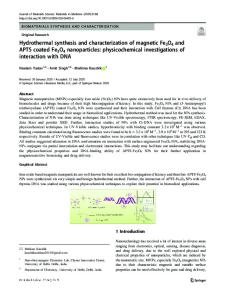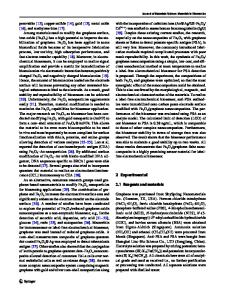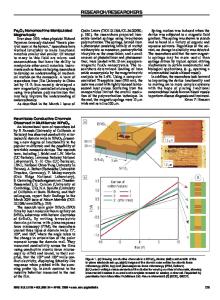Synthesis and electrochemical properties of CeVO 4 /Fe 3 O 4 as a novel anode material for lithium-ion batteries
- PDF / 3,255,405 Bytes
- 9 Pages / 595.276 x 790.866 pts Page_size
- 109 Downloads / 403 Views
ORIGINAL PAPER
Synthesis and electrochemical properties of CeVO4/Fe3O4 as a novel anode material for lithium-ion batteries Xiaoqing Yang 1 & Huimin Wu 1 & Shiquan Wang 1 & Fangyi Cheng 2 & Chuanqi Feng 1 & Kuakun Liu 3 Received: 19 January 2020 / Revised: 12 April 2020 / Accepted: 23 April 2020 # Springer-Verlag GmbH Germany, part of Springer Nature 2020
Abstract The CeVO4/Fe3O4 compound is successfully obtained by combining hydrothermal treatment and water bath process. The final product has been characterized by X-ray diffraction, scanning electron microscopy, and X-ray photoelectron spectroscopy techniques. The electrochemical properties of the expected compound were tested by a battery test system. The obtained CeVO4/Fe3O4 composite shows higher specific capacity and better cyclability than pure CeVO4 prepared under the same conditions. The initial discharge specific capacities of CeVO4 and CeVO4/Fe3O4 are 671.7 and 964.0 mAh·g−1, respectively. After 100 cycles, CeVO4 and CeVO4/Fe3O4 still maintained their discharge capacities at 416.4 and 875.9 mAh·g−1, representing capacity retention rates of 62.0% and 91.0%, respectively. The possible reaction mechanism for the CeVO4/Fe3O4 composite is also discussed. The CeVO4/Fe3O4 composite may be a prospective anode material for the lithium-ion battery. Keywords Inorganic compounds . Anode material . Lithium-ion battery . Electrochemical properties . Chemical synthesis
Introduction The problem of global environmental pollution and energy shortages is becoming more and more serious [1]. The development of new clean energy and new high-power batteries, as well as efficient energy storage systems, is of great significance for environmental protection and efficient utilization of energy [2–5]. The battery industry, as an important part of the new energy industry, has also become an important hotspot for global economic development [6]. At present, lithium-ion batteries are broadly put into use in transportation, electronic communications, and other fields as an important energy source due to their excellent comprehensive performances, including their high energy density and power * Chuanqi Feng [email protected] 1
Hubei Collaborative Innovation Center for Advanced Organic Chemical Materials and Ministry of Education Key Laboratory for Synthesis and Applications of Organic Functional Molecules, Hubei University, Wuhan 430062, China
2
Key Laboratory of Advanced Energy Materials Chemistry (Ministry of Education), Nankai University, Tianjin 300071, China
3
Institute for Superconducting and Electronic Materials, University of Wollongong, Wollongong, NSW 2522, Australia
density [7, 8]. They have broad application prospects in the fields of electric vehicles and energy storage [6–12]. Because of the rapid growth of the high-power battery market, the demand for anode materials is strong. Graphite is the most important commercial anode electrode material, but its theoretical specific capacity limitation (372 mAh·g−1) has led to the exploration of alternative anode materials
Data Loading...











